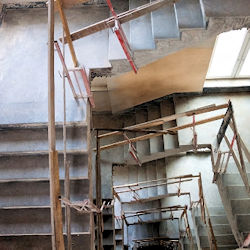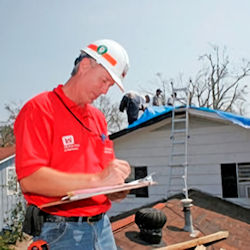SECTION 24 - SAFE ACCESS
24.A General.
24.A.01 Safe access must be provided to work areas and where danger exists of workers falling through floor, roof, or wall openings, or from platforms, runways, ramps, fixed stairs, ladders, or for rope access.
- A stairway, ladder, ramp, or personnel hoist must be provided where there is a break of 19 in (48.2 cm) or more in a route of access.
- Means of access constructed of metal must not be used for electrical work or where the potential exists to contact electrical conductors.
- Means of access between levels must be kept clear to allow free passage of workers. If work is performed in an area that restricts free passage, a second means of access must be provided.
- For all government-owned/operated facilities, every open-sided floor or platform 4 ft (1.2 m) or more above adjacent floor or ground level must be guarded by a guardrail system (or equivalent) along all open sides (except where there is an entrance to a ramp, stairway or fixed ladder). The guardrail system must be provided with a toeboard when necessary. > See Section 21.F.01.
24.A.02 An AHA, accepted by the GDA for the activity in which means of access are to be used, must delineate the following:
- The design, construction, and maintenance of the means of access, and
- Erection and dismantling procedures of scaffolds, including provisions for providing fall protection (FP) during the erection or dismantling when the erection or dismantling involves work at heights. > See Sections 21.K.02 and 22.A.03.
24.A.03 Job-made means of access must be designed to support, without failure, at least four times the maximum intended load and must be constructed according to Section 22 of this manual.
24.A.04 Means of access must not be loaded beyond the maximum intended load for which it was designed or beyond its manufacturer's rated capacity. When loaded, planking and decking must not deflect more than 1/60 the span length.
24.A.05 The width of accessways must be determined by the purpose for which they are built, must be sufficient to provide safe passage for materials and movement of personnel and (except for ladders) must not be less than 18 in (45.7 cm).
24.A.06 Accessways must have overhead protection equal to 2 in (5 cm) solid planking whenever work is performed over them or if personnel are exposed to hazards from falling objects.
24.A.07 Accessways must be inspected daily.
- The walkway must be free of tripping hazards, obstructions and cannot impede or restrict the travel of personnel. In addition, accessways must be kept free of ice, snow, grease and mud or any other environmental hazards.
- Where accessways are slippery, abrasive material must be used to assure safe footing.
- All obstructions or projections into an access way must be removed or conspicuously marked. Obstructions or projections that are sharp, pointed or that may cause lacerations, contusions, or abrasions must be covered with protective material.
- Accessways, including their accessories that become damaged or weakened must not be used. These defective items must be repaired or replaced.
24.A.08 When moving platforms to the next level, the old platform must be left undisturbed until the new bearers have been set to receive the platform planks.
Knowledge Check Choose the best answer for the question.
24-1. For all government-owned/operated facilities, at what height above an adjacent floor or ground level must every open-sided floor or platform be guarded by a guardrail system?
You forgot to answer the question!


